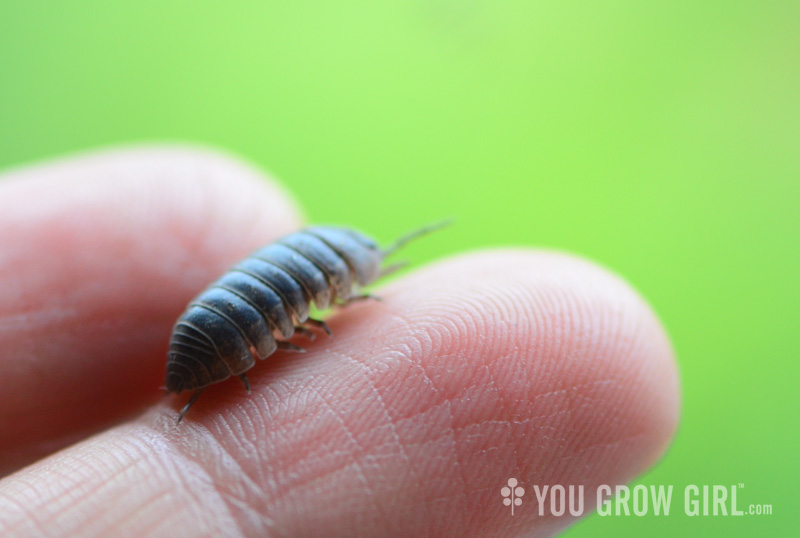
The creature at your feet dismissed as a bug or a weed is a creation in itself. It has a name, a million-year history, and a place in the world. – E. O. Wilson, biologist and naturalist (see Biophilia)
It started with the snails. I’ve been remarking for years that the Banded Wood snails (Cepaea nemoralis) that live in my garden are quite beautiful. I wondered if bringing one indoors and keeping it in a jar would make for some interesting observations and perhaps develop an appreciation for something everyday that lives so close to home. And so, one August day, I grabbed a jar, threw in some soil, sticks, and leaves from the garden that they like to eat most (it’s not difficult to determine which ones!), and just like that, a pest lost an “S” and became a pet.
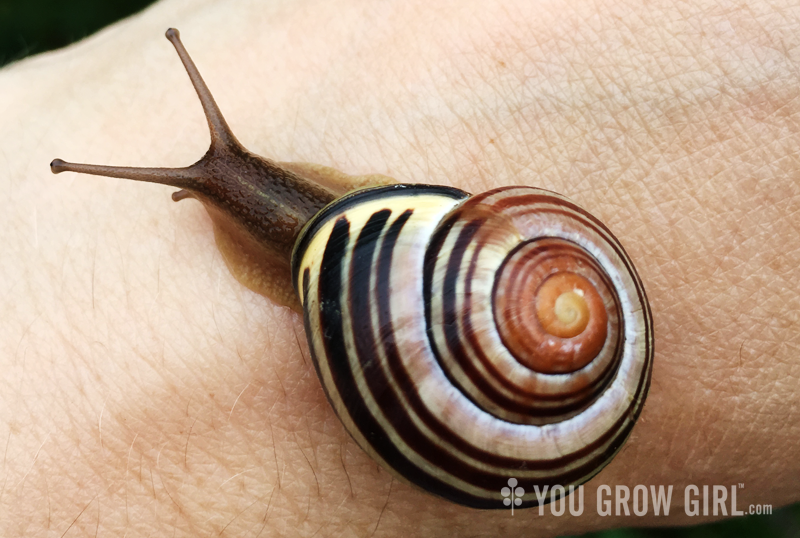
Banded Wood Snail (Cepaea nemoralis)
It wasn’t long before a second snail was added to the jar. Later I found a tiny baby while washing a harvest of leafy greens, and two became three. Turns out two strays, a flat-backed millipede (Oxides gracilus) and a wireworm (Elateridae) also hitched a ride in the soil.
And so there were five.
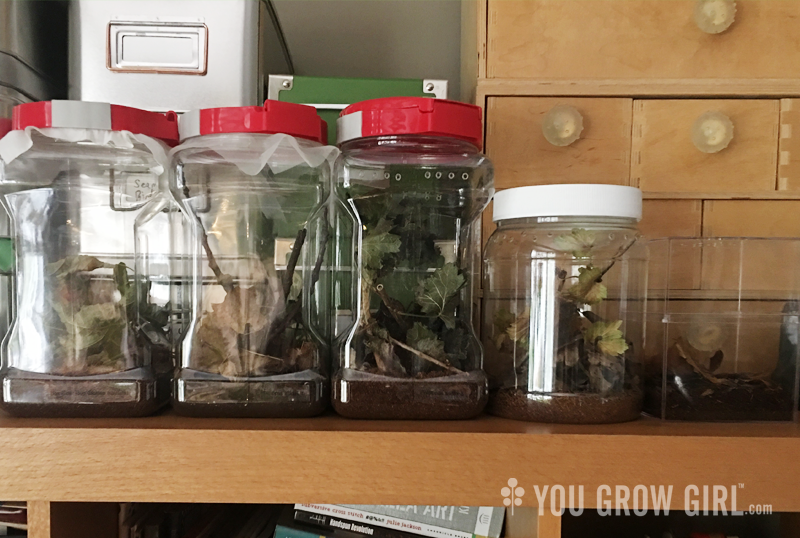
Box Elder bug, three bold jumping spiders, and a rock centipede living on a bookshelf in my office. There are other creatures on other shelves.
The first thing I observed was that snails bury themselves in the soil and disappear for days. How had I never noticed this behaviour before? Given the population of snails in my garden, it seems unlikely that I have never dug one up. The second observation I made was a change in my attitude. I’ve lived in this region my entire life and have been running into these creatures since I was a kid. They are common. Everyday. A fact of any moist place. Yet I never bothered to know their names beyond snail, millipede, wireworm and the plants that they eat: MY hostas, my leafy greens, my root crops. MY garden. The garden was mine, and while I felt a benign sense of acceptance about the fact of their appearance there, these creatures were not special enough to know, and indifference could turn to war should their populations grow large enough to get in the way of what was mine.
But bringing them in changed that immediately. I looked them up in books and memorized their Latin names. I spent lengthy chunks of time watching them move. I sacrificed my favourite garden leaves without a second thought. I went out of my way to set aside the butt end of homegrown zucchinis. I made note of which leaves and fruit and vegetable scraps were their favourites, and whats-more, I truly cared to know. What had once been at the best uninteresting and at the worst pests were now creatures of importance and curiosity. This change in attitude also shifted toward those that remained outside. I paid more attention to the many other snails in the garden and when I picked up a potted plant, I was more curious than usual about who scurried away. I began to ask myself more questions about the other everyday invertebrates that lived alongside me. Not just the pretty or most alien-looking ones, and not just my beloved pollinators. I wondered about those god-awful earwigs, too, with their grasping jaws and spastic movements that give me the willies. Now everyone living in the garden was worth knowing.
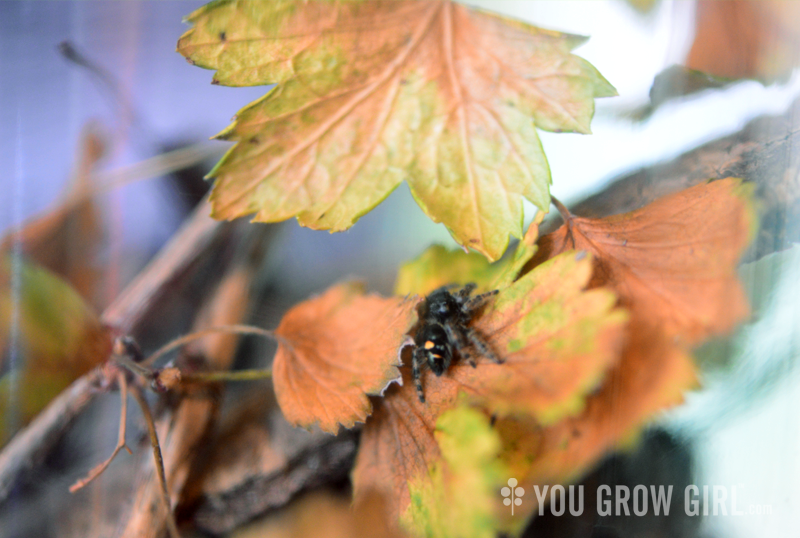
Bold Jumping Spider (Phidippus audax) aka Janice.
As summer turned to fall the annual migration of spiders indoors was in full swing and there were several living in our kitchen window through no intervention of my own. We’d lived this way for years: a mutual arrangement in which they gained room and board by keeping the fruit fly population in check. All we asked was that they stay in the kitchen. The rest of my living quarters, most especially the bedroom, was off limits. For some reason jumping spiders (Phidippus audax) were most popular this year. I’ve always loved jumping spiders. They are fuzzy and curious, and while they do have venom and can bite (as can anything with a mouth), they have good eye-sight and seem as curious about us as we are of them. However, for the first time I found myself bringing indoors almost every jumpy who came out to greet me in the garden. When the temperatures dipped down further I found a box elder bug (Boise trivittata) on our back door. Like spiders they tend to seek shelter inside houses to wait out the winter. I made air holes in a container, added a coir floor, and branches of its favourite local food, Manitoba maple aka box elder maple (Acer negundo) leaves and keys, and now another common house pest was living in a place of prominence on my office bookshelf along with 4 jumping spiders, a rock centipede, two colonies of various isopod species, and an assortment of arachnids (not spiders), the later of which I had purchased. Intentionally. With money. One weekend we rented a car and drove out to a reptile show so I could pick up feeders for my growing invertebrate hoard. Davin was dispatched to various stores in search of bigger and better enclosures. Everyone got a label and a name (Latin and of my own choosing). I checked on them once and twice daily. I took photos for the family album. I spoke to them in a gentle voice and I rooted them on when they caught a fly or devoured a piece a pumpkin.

Vinegaroon (Mastigoproctus sp) aka Dorothy Zbornak
Throughout this time I posted, with trepidation, photos and videos to social media of the invertebrates that had captured my imagination. I felt very consciously aware that people do not subscribe to my feeds to see photos of creepy crawlies, and I know that many have a strong visceral reaction to them, especially arachnids. However, it wasn’t until reader Jenny Thompson thanked me for “normalizing enchantment and curiosity for us grown ass folks” that it occurred to me how abnormal my behaviour was for a 45 year old woman. Bringing bugs indoors and putting them into containers for observation is the playful domain of children. Adults are granted permission to indulge in this behaviour through their work (if they are serious entomologists or educators) or through their kids, but doing it out of our own interest and curiosity is… weird.
One of the reasons why I made my activity book for gardeners, Grow Curious, was to grant adults permission to play in the garden without requiring a child to act as a go-between. Why is it weird to cultivate a curiosity about common garden insects and bring them inside to observe? Why do we need a reason to engage in that sort of play?
In Grow Curious I cite author and illustrator Lynda Barry who is one of my top go-tos on the subject of adults and play. In her workbook for writers, What It Is, she talks about how as adults we mistake childhood play for simple, easy leisure, when in fact, play can be a serious business that helps children work through life problems, cultivate a deeper sense of self within the greater world, and learn. The same can be said for adults. We are taught that as we age growing up means getting “serious”, and focussing our time and effort on being productive and making money. When we do play, it is within acceptable, adult parameters, and often, those forms of play lead back in ways toward growing our social capital. they are still formed around success-seeking. It has been my experience that when I follow my whims and devote time to seemingly meaningless, silly tasks, there are often unseen rewards. Inevitably I always end up gaining new knowledge or a change in perspective that feeds into other areas of my life in positive ways. They may not lead to money or power in the traditional sense, but the value I gain in sheer delight and regaining my sense of self and humanity is priceless.
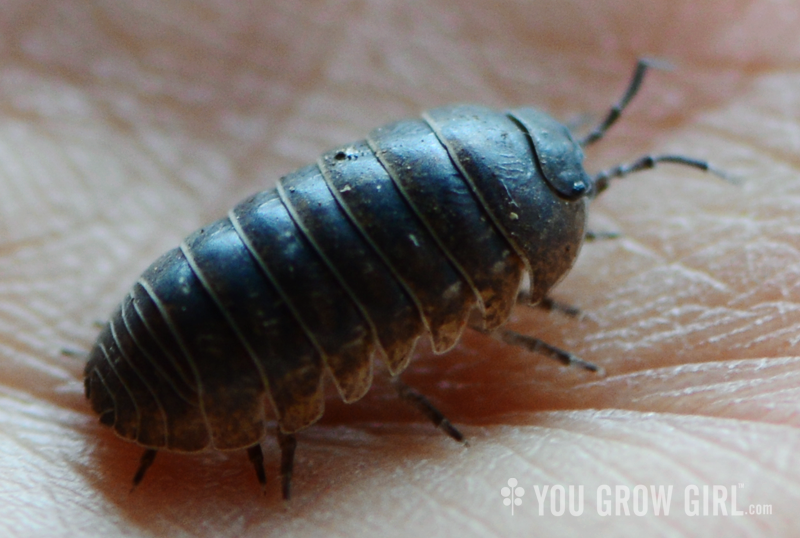
Roly poly (Armadillidium vulgare)
As mentioned, over a short period of time keeping invertebrate gleaned from the garden has offered me the following:
- A new appreciation for the creatures that live close to home: It is easy to be thrilled and captivated about exotic creatures that live outside of my own region. In the past, whenever I travelled to a distant location, I experienced a strong sense of awe and wonder about being surrounded by new creatures and plants. It was always so magical. But over these past months I have found myself feeling that same awe in my own backyard and about common and often even reviled creatures that have been known to me for 40 years. You don’t have to travel more than a few steps to be inspired.
- Knowledge of the creatures who live in my garden that I didn’t have before: On the surface I could say that knowing more about how common garden pests live, what they eat, and what sustains them has made me a more informed, smart gardener. And this is true. I believe that already I would be more adept at locating and capturing them should I want to remove them from the garden more efficiently. But because my perspective has shifted so profoundly, I am finding that I am not so keen to remove or eradicate them. That’s not to say that I won’t. Next June I will still be squashing lily beetles under foot and capturing legions of slugs in beer traps. However, something about this feels like another shift in a trajectory that began when I actively challenged the notion of good and bad bugs in the garden. I think this next one is, in part, about a deeper appreciation for every creature and their place in an evolving ecosystem.
- It is also about me and my own, personal need to keep connecting more deeply with nature and find some peace there. The stuff that is happening in the world right now is overwhelming. We humans are lost and some days it feels that the plunge into a deeper loss of humanity is growing more swift, risking to pull us all under. I’ve lost my sense of safety. For the sake of the health of my nervous system it feels imperative right now to look for the beauty in the world and cultivate an earnest sense of grounding exactly where I am. We need to cultivate biophilia (connecting with nature and other forms of life) more than ever. “To explore and affiliate with life is a deep and complicated process in mental development. To an extent still undervalued in philosophy and religion, our existence depends on this propensity, our spirit is woven from it hope rises on its currents.” – E. O. Wilson
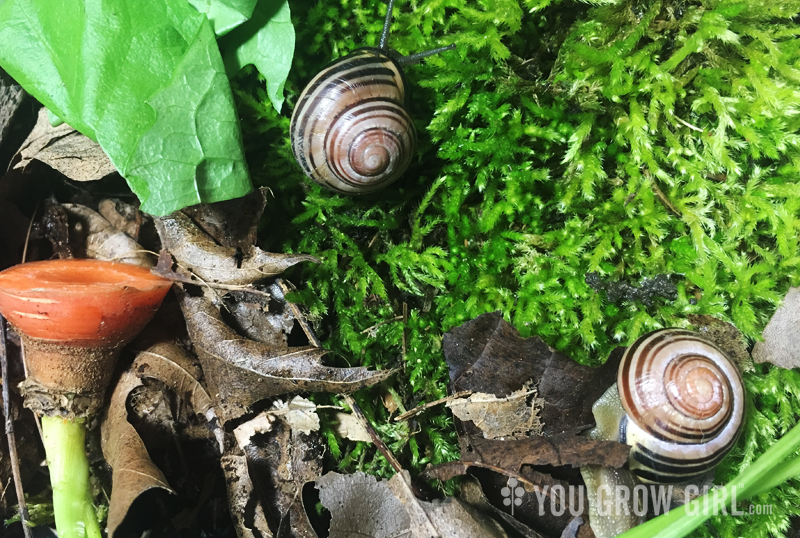
In the spring I will release any garden creatures that have survived the winter indoors back into the garden. Some won’t make it. Many of our local critters have a limited lifespan that is only lengthened a little by time indoors with an accessible food supply and a warm place to live. It will be interesting to discover within that time what more I have learned, and then, in the next growing season how that learning is applied… how it will have unconsciously shaped me as a gardener and as a person.
This was beautifully written and obviously heartfelt. I am really looking forward to weekly posts from you this month!!
Wow, this was amazing. An ample dose of curiosity should not be limited to children – my inner nerd says.
Count me as one of the people who has been enjoying what you share on IG regarding your crawlies! Sometimes I do wrinkle my nose because I’m still working on my own weird phobias with things but I do appreciate it all.
Have you read The Sound of a Wild Snail Eating by Elisabeth Tova Bailey? I think it is right up your alley.
Oh, Gayla. Wow. This is amazing writing — and meticulous observational research.
I saw your Instagram post yesterday about #NaBloPoMo and made a note to myself to set aside time to visit your site and read your blog post.
And I didn’t just read it, I devoured it with excitement and fascination. As KayN says it is beautifully written. I have so much to learn about these “creepy crawlies”, which don’t creep me out at all (although I agree with you about spiders in the bedroom…or bathroom.) And most of all, I agree with you about the need to cultivate biophilia.
I’ve always loved your writing and I’m so glad we will be seeing the long-form version of it here on the blog this month.
(PS Have your read Sy Montgomery’s new book/memoir, “How to be a Good Creature”? I bought a copy yesterday after reading about it on BrainPickings.)
There’s little snails in my garden too, but I’ve never seen any so lovely with the spiral striped patterns. I do like to learn more about the small things that live in my yard- and I’m fond of wolf spiders but I could do without the japanese beetles and the stink bugs! Have you ever read Sound of a Wild Snail Eating? I think you’d really appreciate that book.
Very interesting. I was thinking about the large canning jars that I bought for storage last years. Using screen and the rings to hold it down would be perfect for keeping the oxygen supply going in there. Wish my children were small again. Heck, I wish my grandkids were small again. Great learning experience for the whole family. Thank you for the post. <3